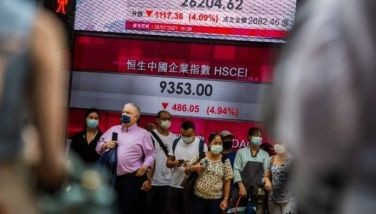Shaking off quake fears

Disaster preparedness has become a big phrase for Filipinos, not just because of the reality of super typhoons and extreme floods, but also because of the threat of earthquakes with the Philippines located within the Pacific Ring of Fire where 90 percent of the world’s earthquakes occur.
Today, be sure to participate – or be involved with the simplest disaster response required, or even by just making it your business to know – in the first-ever metro-wide earthquake disaster preparedness exercise organized by the Metropolitan Manila Development Authority.
Don’t forget the Philippines is ranked third in the world risk index ranking of 173 countries, and third in the global climate risk index of 178. About 75 percent of the country’s population and 80 percent of its land area are vulnerable to disaster, with Manila considered at “extreme risk.”
Consider the following statistics: 58 percent of all disasters in the country are accounted for by typhoons and storms, while 25 percent are accounted for by related flooding and six percent by landslides.
Earthquakes and volcanic eruptions each account for five percent of disasters, while less than one percent is caused by droughts.
While these disasters account for an average of over 1,000 deaths per year, more recent incidents like Typhoon Haiyan (or Yolanda) – plus the realization of worsening global climate conditions – are pulling the mortality figures higher.
Long history of quakes
In terms of earthquake disasters, the Philippines has fallen victim to several high magnitude seismic events. The earliest recorded was in June 25, 1599 when an intensity 6 quake struck Spanish Manila, damaging many private buildings and the city, and ruining the roof of the old Santo Domingo Church.
With 22 active volcanoes, Filipinos are no stranger to tremors that can bring about panic attacks when walls start to tremble, and furniture are thrown helter-skelter. Compared to hydrometeorological events, earthquakes are rare, but can be extremely destructive.
The most celebrated earthquake ever recorded deals with a series of tremors that struck Luzon, including Manila, in 1880, and which happened for 11 days starting on the 14th of July and ending on the 25th. Three violent earth movements within the period caused extensive damage to buildings.
A more recent incident in our history was the magnitude 7.8 quake that struck Luzon on July 16, 1990. Dagupan City partly sank, while Baguio City and Cabanatuan City suffered extensive damage and loss of lives.
For starters
The MMDA-organized earthquake drill today, by all means, cannot be regarded as a perfect deterrent to the loss of property or lives should a real one occur. But it will help to be better equipped to deal with the occurrence, and correctly act when faced with such disaster.
Following the movement of the 8,000-strong Metro Manila Rescue Volunteer Corp. (MMRVC), which will be mobilized today to respond to the different simulated earthquake disasters (such as collapsed buildings or fire), the quake drill will also enable us to know where evacuation sites and other pertinent evacuation locations will be positioned.
Most importantly, this drill should be seen as the first step in a regular series where more people are made aware of the risk of earthquakes, and where “graduates” of the drills will be able to act responsibly, almost by instinct, when an earthquake indeed occurs.
This also brings to fore the need for some serious contingency measures that will mitigate any threats to business discontinuity, much like what happened in 1970 when Typhoon Patsy (Yoling) struck Luzon and flooded the better part of Central Luzon, thus cutting off a large part of the north from the rest of Luzon.
It’s also a good time to review the structural integrity of the metro’s bridges, some of which were built decades ago premised on traffic flow far less stressful than what it is forced to endure these days.
The same goes for stricter monitoring of compliance to the existing building codes, while at the same time, more studies should be undertaken that would consider the effect of a series of strong earthquakes, much like what happened in 1880.
Basics
The government has two websites (www.metromanilashakedrill.com and www.bepreparedmetromanila.com) that have extensive information on today’s disaster preparedness drill. You can also stay tuned to television, radio, and online news coverages today.
It’s best to familiarize yourself with the duck, cover and hold response, which is the recommended individual reaction when a strong earthquake is felt.
While it is ideal for households to have their own fire extinguishers, this should be a must for business establishments, even those on the micro level, to ensure preparedness for any fire eventuality resulting from a strong quake.
Aside from collapsing structures, fire is the most frequent effect of an earthquake. The government, with the Japan International Cooperation Agency, did an extensive assessment of the Valley fault, which runs through Metro Manila and its environs, to identify vulnerable areas according to flammability, evacuation difficulty, and building collapse.
Other LGU initiatives
Ever since Typhoon Ketsana (Ondoy) in 2009 and Haiyan less than two years ago, the Philippine government as well as international and local institutions and organizations have been hard at work to improve people preparedness to climate change disasters at various levels.
At the barangay ranks, thankfully because of improved empowerment and financial resources, local government officials continuously look for ways of improving their disaster response capabilities taking into consideration unique geographical conditions.
It’s not strange now to see LGU vehicles that have water-fording capabilities, or with overhead racks that can carry small boats. More barangays are also now able to buy their own fire trucks that can be operated even in densely populated communities.
To be truly cognizant of the risks of changing climates and real threats to modern life, we must constantly be prepared. So let’s put our minds to this everyday.
Facebook and Twitter
We are actively using two social networking websites to reach out more often and even interact with and engage our readers, friends and colleagues in the various areas of interest that I tackle in my column. Please like us at www.facebook.com and follow us at www.twitter.com/ReyGamboa.
Should you wish to share any insights, write me at Link Edge, 25th Floor, 139 Corporate Center, Valero Street, Salcedo Village, 1227 Makati City. Or e-mail me at [email protected]. For a compilation of previous articles, visit www.BizlinksPhilippines.net.
- Latest
- Trending






























